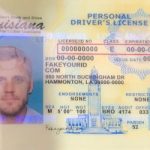Identity verification is a crucial aspect of modern – day society, ensuring security, access to services, and the integrity of various systems. In recent years, the concepts of Real ID and DNA – based ID verification have emerged as significant topics in the field of identification.
Understanding Real ID
Real ID is a federal standard for state – issued driver’s licenses and identification cards in the United States. It was established in response to the 9/11 Commission Report’s recommendations to enhance security and standardize identification documents. A Real ID – compliant card has specific features that make it more difficult to counterfeit, such as enhanced security features and specific data storage requirements.
To obtain a Real ID, individuals are required to provide certain documents to prove their identity, such as a birth certificate, social security number, and proof of residency. This process helps to ensure that the person obtaining the ID is who they claim to be. Real ID is used for various purposes, including boarding domestic flights, entering federal buildings, and accessing certain government – related services. For example, starting from a specific date, travelers in the U.S. must present a Real ID – compliant driver’s license or other approved identification to board a domestic flight.

The Rise of DNA – Based ID Verification
DNA – based ID verification is an emerging technology that holds great promise for the future of identification. DNA, or deoxyribonucleic acid, is unique to each individual (except in the case of identical twins). By analyzing an individual’s DNA, it is possible to create a highly accurate and unique identifier.
The process of DNA – based ID verification typically involves collecting a DNA sample, such as through a saliva swab or a blood sample. The sample is then analyzed in a laboratory to extract and analyze specific genetic markers. These markers can be used to create a DNA profile that can be compared to a pre – existing database for identification purposes. In criminal investigations, DNA evidence has been used for decades to identify suspects and victims. In the future, this technology could be expanded to more general identity verification scenarios.
One potential application of DNA – based ID verification is in high – security areas, such as government facilities, military bases, or secure laboratories. Instead of relying solely on traditional forms of identification like ID cards or passwords, DNA – based verification could provide an additional layer of security. For example, access to a top – secret research facility could require a DNA match in addition to other forms of authentication.
Comparing Real ID and DNA – Based ID Verification
While Real ID and DNA – based ID verification both aim to enhance identity verification, they have significant differences. Real ID is a document – based system that relies on physical documents and certain security features on the card. It is a more widespread and currently operational system for general – purpose identification within a country. On the other hand, DNA – based ID verification is a biometric system that uses an individual’s genetic information. It offers a higher level of uniqueness and accuracy, but it is still in the developmental and experimental stages for many non – forensic applications.
Another difference lies in the accessibility and practicality. Real ID is relatively easy to obtain for most individuals who meet the requirements and can provide the necessary documents. It can be used in a variety of everyday situations, such as driving or air travel. DNA – based ID verification, however, requires specialized equipment and laboratory analysis. It may not be as practical for widespread, on – the – spot identification in the near future, but it could be used in more controlled and high – security environments.
Challenges and Considerations for DNA – Based ID Verification
One of the main challenges for DNA – based ID verification is privacy. DNA contains a vast amount of personal and genetic information. Storing and using this information raises significant privacy concerns. For example, if a DNA database is hacked, the genetic information of millions of individuals could be exposed, leading to potential misuse, such as genetic discrimination in employment or insurance. To address this, strict regulations and security measures need to be in place to protect the privacy of individuals’ DNA data.
Cost is also a factor. The equipment and laboratory analysis required for DNA – based ID verification are currently expensive. This could limit its widespread adoption, especially in applications where cost – effectiveness is crucial. Developing more cost – efficient DNA analysis techniques and technologies will be essential for the future of this form of identification.
There are also ethical considerations. For example, issues related to informed consent when collecting DNA samples and the potential for misinterpretation of DNA data need to be carefully considered. Informed consent ensures that individuals are fully aware of how their DNA will be used and stored. Misinterpretation of DNA data could lead to false identifications or incorrect conclusions.
Future Integration and Coexistence
It is possible that in the future, Real ID and DNA – based ID verification could coexist and even be integrated in some way. For example, a Real ID could be enhanced with a DNA – based component for added security in certain high – risk situations. A traveler going through a high – security checkpoint could present their Real ID and also provide a DNA sample for additional verification. This integration could combine the practicality of Real ID with the high – accuracy of DNA – based verification.
Another possibility is that DNA – based ID verification could be used as a secondary or backup identification method in case of lost or stolen Real IDs. For example, if a person’s Real ID is lost, they could use their DNA – based profile to prove their identity and obtain a replacement ID. This would add an extra layer of security and convenience to the identification process.
Common Problems and Solutions
- Problem: Difficulty in Obtaining Real ID Documents
Some individuals may have trouble obtaining the required documents for a Real ID, such as a birth certificate. This could be due to lost or damaged records, or in the case of adopted individuals, access to original birth records may be restricted.
Solution: Governments can establish more accessible and streamlined processes for document replacement. For example, online platforms can be created where individuals can apply for duplicate birth certificates or other necessary documents. Additionally, in the case of adopted individuals, more flexible regulations can be put in place to ensure they can obtain the required identification – related documents.
- Problem: Privacy Concerns Regarding DNA – Based ID Verification
As mentioned earlier, the storage and use of DNA data raise significant privacy issues. There is a fear that this data could be misused or accessed by unauthorized parties.
Solution: Stringent laws and regulations should be implemented to govern the collection, storage, and use of DNA data. Data protection measures such as encryption, access controls, and regular audits should be in place. Additionally, individuals should have the right to know how their DNA data is being used and have the option to opt – out in certain non – mandatory situations.
- Problem: High Cost of DNA – Based ID Verification
The current cost of DNA analysis equipment and laboratory services makes it less feasible for widespread use.
Solution: Research and development efforts should be focused on developing more cost – effective DNA analysis techniques. This could involve the use of new technologies such as portable DNA analysis devices or more efficient laboratory processes. Additionally, economies of scale can be achieved as the technology becomes more widespread, reducing the overall cost per analysis.
- Problem: False Positives or False Negatives in DNA – Based ID Verification
There is a small possibility of false positives (incorrectly identifying someone as a match) or false negatives (failing to identify a match) in DNA – based ID verification due to factors such as sample contamination or errors in the analysis process.
Solution: Quality control measures should be implemented in DNA analysis laboratories. This includes strict sample handling procedures, regular calibration of equipment, and the use of multiple genetic markers for analysis. Additionally, a system of re – verification and second opinions can be put in place in case of uncertain results.
- Problem: Lack of Public Awareness and Acceptance of DNA – Based ID Verification
Many people may not be aware of DNA – based ID verification or may be hesitant to accept it due to concerns about privacy, ethics, or a lack of understanding of the technology.
Solution: Public awareness campaigns should be launched to educate people about the benefits, risks, and safeguards of DNA – based ID verification. These campaigns can include information sessions, brochures, and online resources. Additionally, involving the public in the development and regulation of DNA – based ID verification can help build trust and acceptance.
Fake ID Pricing
unit price: $109
| Order Quantity | Price Per Card |
|---|---|
| 2-3 | $89 |
| 4-9 | $69 |
| 10+ | $66 |



